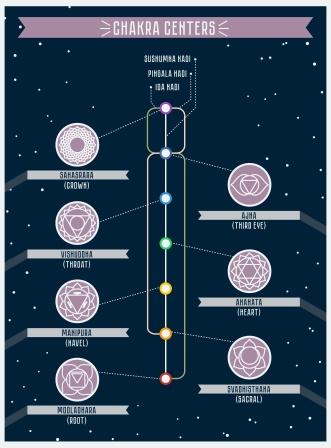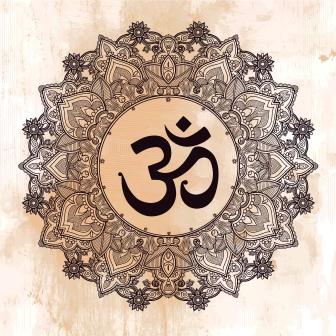Analysis Of Effect of Mantras On Health And Nadi
By Prof. Vd. Rangaprasad Bhat
The sound vibrations caused by reciting the mantras influences the sub nadis within the human system controlling the major six Chakras and the remaining minor Chakras.
Table of Contents
Introduction
The microcosmic universe within the human system gets connected to the macrocosmic universe outside the human system and receives the required amount of energy for self healing through the recitation of the mantras.
Like the pranayama helps in controlling the breath in activating the energy centers within the physiologically functioning Kundalinis, the Mantras, where in the meters of notes varies with in the verses of it,- indirectly without the knowledge of the chanting person, takes care of the controlling of breathing pattern almost similar as when one does the Pranayama.

The ascendo and crescendo metres of notes changes the breathing pattern and there by receives the Maha Prana Vayu in a rhythmic manner through the rhythmic pattern of chanting. And thus creates a vibration with in the human system through the nāḍis and the ap mahābhūta (which constitutes the major portion of human system).
14 divisions of Nadi
1. Suśumna
2. īda
3. Piṅgala
4. Gandhāri
5. ḥastajihva
6. Kuhu
7. Sarasvati
8. Puśa
9. ṣankhini
10. Payaśvini
11. Varuṇī
12. ālambuṣa
13. Viśvodhara
14. Yaśasvini.
These are the 14 divisions of the nāḍis.
Each of these nāḍis, origin from a specific point and traverse along various structures within the body like the external and internal marmas known as minor Chakras, the sphlanchnic organs and the sensory organs.
The energy pattern within these nāḍis gets influenced by the breathing exercises and other yogic procedures like bandha.
It is understood that when the energy pattern within the nāḍis are in unison and harmonious pattern of working the person remains in an healthy state and when the energy distribution gets disturbed with either blockade in any meeting points of these channels or if there be over activity within a particular channel there by creating an imbalance within the synchronicity maintained amongst other nāḍis, the person results in a diseased state.
Like a string of veena when pulled to create a sound causes vibration within the string reaching from one oint to the other, the Omkara present in the subtlest form within the verses of the mantrās when recited with a specific meter creates the vibrations within the major nāḍis the iḍā,piñgala and suṣumnā.
The union point of the iḍā, piñgala over the center point of suṣumnā is present at the back of the head. It is believed to be the place where the Amrita Bindu gets secreted in yogic kriyā practices of inciting the kuṇḍalini, casuing the paramānanda (blissful feeling). It may be noted that for the experience of bindu, proper nāda (sound) and kalā (metre) are needed.
The sound created by verses of the hymns with the kalā factor being taken care of the metres, when recited incites the ida iḍā,piñgalādi 14 nāḍis depending upon the sensitivity caused by the frequency produced by the combination of the nāda and kalā and there by incites a blissful state of experience in the bindu region.
The mantrās, the musical notes etc do create a vibratory experience within the human system based upon the above concept of nāda, bindu and kalā.
Through the spanda or reverberation or vibration as in pulsation one can sense both the nāda and bindu. All things in the universe does have vibrations innately in them. No any object or living being is with a fixed form. Changes do happen in them when there occurs a change in the innate vibrations they hold with in. Kalā too is associated with spanda and depending upon the vibrations it produces various types of patterns. The pañcamahābhūtās in a way are nothing but patterns of energy and vibrations. The spandana in prthvi are slower and gross which increases in uttarottara bhūtās to attain subtler and very dynamic ākāśa. Only hence in yogic practice each of the cakrās do have different vibrations. The mūladhāra having lowest vibration to sahasrāra having highest frequency of vibration. And the yogic practices of haṭhayoga in a way holds the secret in increasing the vibration emanating capacity of oneself to strengthen the lower to higher cakrās individually in a step by step order.
Mantra has the inner ability to change the vibratory rate of manas and prāṇa. And it is an easier way of bringing transformation of increase in higher levels of vibrations from lower to higher cakrās, to beget an expanding awareness of one’s soul.
The mantra So aham – सोऽहम् (That I Am) has the highest mode of vibrations and helps one attain śivatvaṃ through vāsi.
There can be no śabda (sound) without vibration or motion (spanda), the former being the consequence of the latter. Over the physical plane we usually observe the forms of matter being produced by the combination or by the variations and permutations of its particles, be it in solid, liquid or gaseous states. The above functions actually imply motion or vibration and thus there can be no formation or form without the involvement of any movement.
When the process of evolution began, this Svara, this great power, threw itself into the form of ākāśa, and thence respectively one after the other into the form of vāyu (air), agni (fire), āpas (water) and prithivī (earth). It does the same when it enters the involutionary process.
Motion is actually caused by the difference in the density of material particles, the solid being moved by the liquid and the liquid by the gas. The general notion in physics is that,- a dense substance is moved in; by; or through a subtle one.
The modern physics applies this law only to physical matter, i.e.,Mahābhūta (gross matter). And that it could only reach up to ether.Beyond that it ignores to explore on the ground, because of its incognizability using physical instruments and pratyakśa pramāṇa. On the contrary the Eastern one, goes far beyond it, through yogic vision and in a way through quantum physics.
The influence of vibrations of sound over matters could be imagined with the help of chymatics.
The German musician and physicist Ernst Chladni noticed in the eighteenth century that the modes of vibration of a membrane or a plate can be observed by sprinkling the vibrating surface with a fine dust (e.g., lycopodium powder, flour or fine sand). The powder moves due to the vibration and accumulates progressively in points of the surface corresponding to the sound vibration. The points form a pattern of lines, known as nodal lines of the vibration mode. The normal modes of vibration, and the pattern of nodal lines associated with each of these, are completely determined, for a surface with homogeneous mechanical characteristics, from the geometric shape of the surface and by the way in which the surface is constrained.
In 1967 Hans Jenny, a follower of the anthroposophical doctrine of Rudolf Steiner, published two volumes entitled Kymatic (1967 and 1972), in which, repeating Chladni’s experiments, he claimed the existence of a subtle power based on the normal, symmetrical images made by sound waves. Jenny put sand, dust and fluids on a metal plate connected to an oscillator which could produce a broad spectrum of frequencies. The sand or other substances were organized into different structures characterized by geometric shapes typical of the frequency of the vibration emitted by the oscillator. (reference)It should be noted that modern analysts, including Michael Shermer, have termed anthroposophy’s application in areas such as engineering, medicine, biology, and biodynamic agriculture as pseudoscience.

According to Jenny, these structures, reminiscent of the mandala and other forms recurring in nature, would be a manifestation of an invisible force field of the vibrational energy that generated it. He was particularly impressed by an observation that imposing a vocalization in ancient Sanskrit of Om (regarded by Hindus and Buddhists as the sound of creation) the lycopodium powder formed a circle with a center point, one of the ways in which Om – ॐ, had been represented.
In fact, for a plate of circular shape, resting in the centre (or the border, or at least in a set of points with central symmetry), the nodal vibration modes all have central symmetry, so the observation of Jenny is entirely consistent with well known mathematical properties.
Necessity of Sankalpa
Necessary of sankalpa prior to chanting:-
Primarily, before beginning with the chanting, the person need to do sankalpa which means the purpose of desire or intention of chanting the mantra. This becomes essential to bring in the focus of the ātma and manas to come in close association with the indriyas used while chanting the mantras (indriyārtha sannikarṣa),so as to initiate the process of self healing of the body by receiving the concerned energies from the macrocosm to the microcosm through the mantrās.
Click to consult Prof. Vd. Rangaprasad Bhat









4 comments
Maah
Hare Krishna!
DrPiroja Pardiwalla
Very well written Sir. I appreciate it.
I have a query. Recitation of “So aham” or “Om” repeatedly as a mantra….which of these two is more powerful? What is the purpose of chanting “So aham” and what is the purpose of chanting “Om” specifically? What is each used for?
Thank you very much.
Dr. Piroja Pardiwalla
Dr J V Hebbar MD(Ayu)Author
Hi, So aham – means, that almighty power is myself or That almighty power resides within me. It is useful to improve self confidence.
Om improves concentration, practiced best, ahead of any prayer / Mantra chanting for a few times. This is my little understanding.
M
Both are equally powerful as a tool it just depends how they are used. Soham or Sohum (सो ऽहम् so ‘ham or so ‘Hum) is a Hindu mantra, meaning “I am He/She/That” This is connected to the understanding the principal of Vedanta. Om helps open the 3rd eye and it should be aimed at that area. It should have intonation strong tone coming from the gut. Long with OMMMMM when you hit the MMMM close your mouth. They both have purpose so it depends how they are used like any tool. Ommmm Soham can be combined.
Soham – I am That, I am Pure Consciousness. It connects to Lord Shiva.
Soham – This Mantra expresses the experience of knowing the self , knowing that we are all pure consciousness, personified by SHIVA. Meaning of Mantra Soham – I am that Shivoham – I am Shiva, I am pure Consciousness Meditating on this mantra leads us to our higher self, our true nature.
OM – Om is defined by Hindu scripture as being the primordial sound of creation. It is the original vibration of the universe. From this first vibration, all other vibrations are able to manifest.
By chanting Om, we can align our frequency with that of the original universal frequency, which is essential in spiritual practice. As an iron rod becomes as hot as fire when it comes in contact with its flames, a person can spiritualize their life by staying in contact with the spiritual energy of the Absolute.
The Power of So’Ham
So’ ham is a mantra that is clarifying, helping your mind connect with itself and its own divine nature. It is believed to help you get in touch with your higher self; that witnessing presence that becomes so much clearer when the mind is quiet.
Read: Good VIbrations: How to Achieve Higher Consciousness With Positive Vibes
This mantra is unique and can be used in a few different ways. So’ham contains within itself an inherent rhythm that naturally aligns with your breathing. So this is a perfect mantra to let murmur in your mind as you meditate, gently aligning it with your breath.